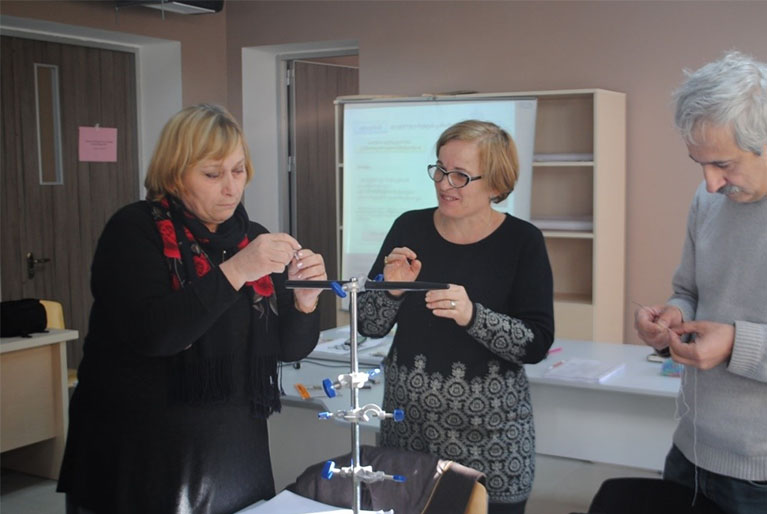Creating the conditions for change: Training teachers and school leaders in parallel

High-quality professional development is designed to steer learners through a process of learning and behavior change leading to improved performance. A wide range of organizational and cultural factors influence the effectiveness of training and learners’ ability and motivation to progress beyond learning new skills to applying and spreading them. This is true for teacher professional development, where teachers’ attempts to apply newly acquired skills can be negatively influenced by the prevalence of outdated methods in their schools and a lack of understanding and support from school leadership. Delivering parallel professional development to school leaders can be an important lever for improving outcomes of teacher professional development.
As part of the Training Educators for Excellence (TEE) project, IREX supported the Republic of Georgia’s Ministry of Education, Science, Culture and Sport (MoESCS) to deliver training to 18,000 teachers, over 4,000 school principals and school-based teacher coaches, to improve instructional leadership and introduce more student-centered practices. Over two years, both groups participated in professional development to learn, apply and reflect on new practices though a series of training modules. The modules included readiness materials and activities, face-to-face training, follow-on assignments (practical application), and professional learning community meetings.
This brief outlines our learning from the development and launch of this parallel professional development cycle for teachers and school leaders.
Develop complementary learning outcomes across teacher and school leader training
The development of complementary learning outcomes and cross-referencing content for teachers and school leaders enables both groups to progress through a learning journey together, preparing each for their respective roles in facilitating change. In Georgia, training prepared teachers for reflective practice and student-centered instruction, first building core pedagogical knowledge and then introducing intensive training in subject-specific teaching methodology to tailor their newly acquired skills to their subject area. In parallel, the Leadership Academy for school principals and school-based teacher coaches provided educational leaders with the training and tools necessary to foster a culture of instructional leadership focused on student-centered teaching and continuous improvement.
Trainings included structured opportunities for reflection – quarterly meetings for the school leaders and professional learning communities for teachers – facilitating an ongoing dialogue on student-centered instruction at both teaching and management levels.
Create a common language for change
Parallel development of teacher and school leader curriculum can create a common language for change. While it may be appropriate for different instructional designers to develop each track of training, care should be taken to ensure consistency of technical terms and approaches. In Georgia, IREX developed a glossary of key terms to assist training developers and sought opportunities for the Leadership Academy and teacher training developers to interact and share content.
Carefully schedule school leader and teacher training to support buy-in and application of learning
Carefully scheduling school leader and teacher training can reinforce the application of new skills in both groups. The Leadership Academy and teacher training was carefully scheduled to achieve complementary learning outcomes as and when needed in both groups. School leaders were introduced to student-centered learning, professional learning communities and instructional leadership, shortly before teachers participated in training on student-centered methods. As a result, while teachers applied new practices and participated in their first professional learning community meetings, school leaders demonstrated institutional buy-in to their reforms to teaching practice.
Similarly, teachers were supported to develop high-quality lesson plans and integrate formative assessment shortly before school leaders learned how to analyze instructional activities designed by teachers and evaluate the alignment of instruction and assessment.Such scheduling ensures that teachers and school leaders tasked with applying their learning find an audience with a shared understanding of the key concepts and objectives of the practice.
Link teachers and school leaders’ follow-on assignments
The complementarity of teacher and school leader training can be reinforced by specifically linking the post training assignments and activities in each group. For example, if teachers are tasked with developing and delivering a lesson plan and reflecting on their practice, while school leaders are soon after tasked with observing lessons and providing constructive and sensitive coaching to their teachers, both groups are prompted to work together toward the common objective of applying student-centered practices in their school.
TEE also sought to further reinforce links between the Leadership Academy and teacher training by engaging principals in teachers’ professional learning communities. Following their training on adult learning, mentoring, conflict management and collaborative professional learning, principals were engaged in supporting the formation and facilitation of teacher professional learning communities in their schools. IREX developed a Study Group Guide for teachers and principals to support these efforts.
Conclusion
Both teachers and school leaders perceived benefits to parallel training. In interviews and focus groups conducted by IREX in early 2019, teachers reported feeling professionally invigorated, in part because they received new support from their school administration. Additionally, in IREX’s 2017 Interim Review of the Leadership Academy, principals cited improvements to teachers’ practices in and outside the classroom – attributed to their training – as important enabling factors for principals’ own reforms. Preliminary findings of an external mid-term evaluation also found that teachers’ motivation and morale was increased by positive changes in their schools’ leadership, and that educational leaders felt better able to support teachers to implement improved practices including refining lesson plans, using differentiated instruction, and applying classroom assessment. Parallel training therefore seems to have played an important role in the learning gains of both groups.
The benefits of parallel support to teachers and principals was subsequently recognized and adopted by the MoESCS as a central component of their nation-wide New School Model Initiative (NSM), which is providing intensive coaching to both teachers and principals as they develop individualized school-level plans.